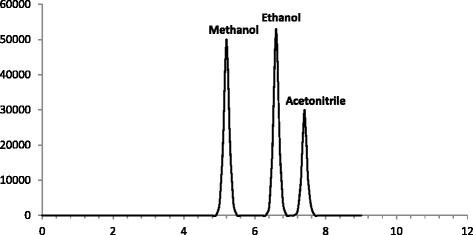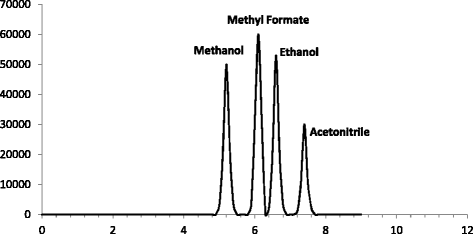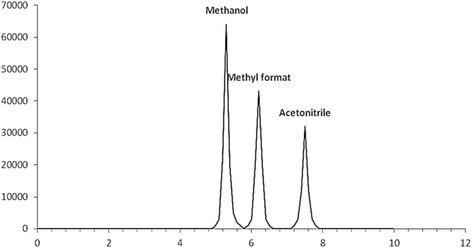Simultaneous measurement of formic acid, methanol and ethanol in vitreous and blood samples of postmortem by headspace GC-FID
- PMID: 29321805
- PMCID: PMC5759182
- DOI: 10.1186/s12995-017-0184-3
Simultaneous measurement of formic acid, methanol and ethanol in vitreous and blood samples of postmortem by headspace GC-FID
Abstract
Background: Formic acid (formate) is the main reason for toxicity and death through methanol poisoning. The simultaneous determination of methanol, ethanol, and formate in the body can help to discover the cause of death and is useful in the diagnosis of acute methanol poisoning. The measurement of formate is not yet available in Iran. With regard to the increasing rate of methanol poisoning and its related mortality in Iran, as well as the main role of formate in methanol poisoning, this study was designed to set up an analytical method for the concurrent determination of ethanol, methanol, and formate.
Methods: Following the modification of a previously developed gas chromatography method, vitreous and blood samples of 43 postmortem cases with a history of methanol intoxication were collected over a period of 2 years at the Legal Medicine Organization of Mashhad. Thereafter, ethanol, methanol, and formate concentrations were measured by headspace GC/FID. Formate esterification was performed by the methylation of formate with sulfuric acid and methanol. In order to confirm the esterification method for the production of methyl formate, we used gas chromatography with a mass detector (GC/MS) because of its higher sensitivity and accuracy. Furthermore, the correlations between formate and methanol concentrations in blood and vitreous samples, and between formate and methanol were investigated.
Results: A significant relationship was found only between methanol concentrations in blood and vitreous samples (P < 0.03).
Conclusions: In postmortems, with the passage of time since alcohol ingestion, the measurement of only methanol concentration cannot determine the degree of toxicity or the cause of death. Therefore, using the present analytical method and measurement of formic acid, we can estimate the degree of toxicity and cause of death.
Keywords: Formic acid; Measurement; Methanol; Methyl formate; Poisoning; Postmortem.
Conflict of interest statement
This work provided by Tehran Legal Medicine Research Center Ethics Committee.Not applicable.The authors declare that they have no competing interests.Springer Nature remains neutral with regard to jurisdictional claims in published maps and institutional affiliations.
Figures




Similar articles
-
The relationship of methanol and formate concentrations in fatalities where methanol is detected.J Forensic Sci. 2007 Nov;52(6):1376-82. doi: 10.1111/j.1556-4029.2007.00554.x. Epub 2007 Sep 15. J Forensic Sci. 2007. PMID: 17868264
-
Post-mortem analysis of formic acid disposition in acute methanol intoxication.Forensic Sci Int. 2003 Apr 23;133(1-2):152-8. doi: 10.1016/s0379-0738(03)00071-9. Forensic Sci Int. 2003. PMID: 12742704
-
Comparison of Quantitative Values of Headspace Gas Chromatography--Mass Spectrometry and a Formate Quantification Kit in Blood Formate Quantification.J Anal Toxicol. 2023 Apr 14;47(4):338-345. doi: 10.1093/jat/bkac107. J Anal Toxicol. 2023. PMID: 36546725
-
American Academy of Clinical Toxicology practice guidelines on the treatment of methanol poisoning.J Toxicol Clin Toxicol. 2002;40(4):415-46. doi: 10.1081/clt-120006745. J Toxicol Clin Toxicol. 2002. PMID: 12216995 Review.
-
Development and characterization of a rodent model of methanol-induced retinal and optic nerve toxicity.Neurotoxicology. 2000 Jun;21(3):321-30. Neurotoxicology. 2000. PMID: 10894122 Review.
Cited by
-
A Smart Colorimetric Platform for Detection of Methanol, Ethanol and Formic Acid.Sensors (Basel). 2022 Jan 13;22(2):618. doi: 10.3390/s22020618. Sensors (Basel). 2022. PMID: 35062579 Free PMC article.
-
Development and validation of headspace gas chromatography with a flame ionization detector method for the determination of ethanol in the vitreous humor.Open Med (Wars). 2025 Jan 15;20(1):20241123. doi: 10.1515/med-2024-1123. eCollection 2025. Open Med (Wars). 2025. PMID: 39822986 Free PMC article.
-
Accidental formalin poisoning in a child with acute fatal manifestations: A rare case report.J Family Med Prim Care. 2022 Jun;11(6):3293-3297. doi: 10.4103/jfmpc.jfmpc_1790_21. Epub 2022 Jun 30. J Family Med Prim Care. 2022. PMID: 36119238 Free PMC article.
-
Efficient nickel or copper oxides decorated graphene-polyaniline interface for application in selective methanol sensing.RSC Adv. 2021 Aug 25;11(46):28573-28580. doi: 10.1039/d1ra04164a. eCollection 2021 Aug 23. RSC Adv. 2021. PMID: 35478552 Free PMC article.
-
Variables that predict nurses' job stress and intention to leave during the COVID-19 pandemic in Turkey.J Adv Nurs. 2025 Feb;81(2):878-886. doi: 10.1111/jan.16287. Epub 2024 Jun 21. J Adv Nurs. 2025. PMID: 39031791 Free PMC article.
References
-
- Haddad LM, Winchester JF. Clinical management of poisoning and drug overdose. 4th edition. Philadelphia: WB Saunders company; 2007.
-
- Lanigan S. Final report on the safety assessment of methyl alcohol. Int J Toxicol. 2000;20:57–85. - PubMed
-
- Wiener S, et al. Toxic alcohols. 2006.
LinkOut - more resources
Full Text Sources
Other Literature Sources
Miscellaneous

